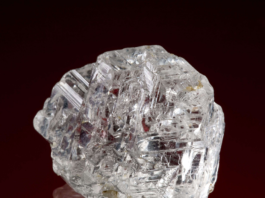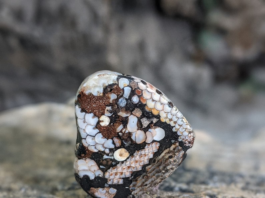Macedonian Green Opal is a unique variety of opal characterized by its vibrant green coloration and translucent to opaque appearance. It belongs to the opal gemstone family, renowned for its mesmerizing play-of-color caused by the diffraction of light within its structure. This particular variety, originating from Macedonia, stands out due to its distinctive green hue, which sets it apart from other opals found worldwide.

Geological Background: The formation of Macedonian Green Opal is closely linked to geological processes involving the interaction of silica-rich solutions with host rocks over millions of years. Opals in general form when water containing dissolved silica seeps into cracks and cavities within certain types of rocks, such as sandstone or volcanic rocks. As the water evaporates, silica deposits are left behind, gradually forming opal.
In the case of Macedonian Green Opal, specific geological conditions unique to the region contribute to its formation. The presence of mineral-rich solutions and the geological history of Macedonia play crucial roles in imparting the distinct green color to the opal. While opals can form in various environments, the combination of factors in Macedonia gives rise to this exceptional green variety.

Historical Significance: The historical significance of Macedonian Green Opal is intertwined with the cultural heritage of the region and its association with opal mining and trade. Opals, including the green variety, have been prized for their beauty and mystical properties throughout history, with references dating back to ancient civilizations.
In Macedonia, the mining and trade of opals, including the green variety, have contributed to the local economy and cultural identity. The presence of opal deposits in the region has attracted attention from gemstone enthusiasts and collectors worldwide. Additionally, Macedonian Green Opal holds significance in jewelry-making, where its unique color and optical properties are appreciated for creating distinctive and eye-catching pieces.
Overall, Macedonian Green Opal represents not only a geological marvel but also a cultural and economic asset for the region, reflecting the enduring allure and value of opals in human history.
Contents
Geological Formation of Macedonian Green Opal

The geological formation of Macedonian Green Opal is a fascinating process involving specific geological conditions that contribute to its unique characteristics, particularly its vibrant green color. While opals in general form through similar processes, the specific geological environment of Macedonia plays a crucial role in the formation of this distinctive variety.
- Presence of Silica-Rich Solutions: Opals, including Macedonian Green Opal, form when silica-rich solutions, typically derived from the weathering of silica-rich rocks like granite, seep into cavities and fissures within host rocks. Silica (SiO2) is the primary component of opal, and its abundance in the solution is essential for opal formation.
- Interaction with Host Rocks: In Macedonia, the geological substrate consists of a diverse range of rocks, including sedimentary, igneous, and metamorphic rocks. These rocks provide the framework for opal formation, offering suitable crevices and fractures where silica-rich solutions can infiltrate and deposit silica over time.
- Volcanic Influence: Volcanic activity has played a significant role in shaping the geological landscape of Macedonia. Volcanic rocks, such as tuff and andesite, can provide ideal conditions for opal formation due to their porous nature and ability to trap silica-rich solutions. The presence of volcanic activity in the region may contribute to the unique chemical composition of the solutions, influencing the coloration of the resulting opals.
- Mineral Impurities: The presence of trace elements and mineral impurities in the silica solutions can impart color to the opal. In the case of Macedonian Green Opal, the green hue is likely attributed to the presence of certain elements, such as nickel or copper, which interact with light to produce the characteristic coloration.
- Temperature and Pressure Conditions: The temperature and pressure conditions prevailing during opal formation also influence its properties. In Macedonia, the geological history and tectonic activity may have subjected the silica-rich solutions to specific temperature and pressure regimes, affecting the internal structure and optical properties of the opals formed.
Overall, the geological formation of Macedonian Green Opal is a complex interplay of factors, including the availability of silica, geological substrate, volcanic influences, and chemical composition of the solutions. These factors combine to create the conditions conducive to the development of opals with the distinct green coloration characteristic of the Macedonian variety.
Physical Properties of Macedonian Green Opal

The physical properties of Macedonian Green Opal encompass a range of characteristics that contribute to its unique appearance and appeal as a gemstone. These properties include color, transparency, hardness, density, and optical characteristics. Here’s an overview:
- Color: The most distinctive feature of Macedonian Green Opal is its vibrant green coloration. The green hue can vary from pale and translucent to deep and opaque, with shades ranging from mint green to forest green. The presence of trace elements or mineral impurities, such as nickel or copper, may contribute to the green coloration.
- Transparency: Macedonian Green Opal can exhibit varying degrees of transparency, ranging from translucent to opaque. Some specimens may have a semi-transparent appearance, allowing light to pass through and create a subtle glow, while others may appear more opaque, with less light transmission.
- Hardness: On the Mohs scale of mineral hardness, which ranges from 1 (softest) to 10 (hardest), opal typically falls between 5.5 and 6.5. Macedonian Green Opal shares similar hardness characteristics with other opal varieties, making it moderately durable for use in jewelry and ornamental purposes. However, it requires careful handling to prevent scratches and damage.
- Density: The density of Macedonian Green Opal varies depending on factors such as composition, porosity, and impurities. Opals generally have a density ranging from 1.98 to 2.25 grams per cubic centimeter (g/cm³). The density of Macedonian Green Opal falls within this range, with variations based on specific geological conditions and mineral content.
- Optical Characteristics: Opals are renowned for their unique optical phenomenon known as play-of-color, which results from the diffraction of light by the silica spheres or layers within the gemstone. While Macedonian Green Opal may exhibit play-of-color in certain specimens, its primary appeal often lies in its vivid green coloration rather than iridescence. However, under certain lighting conditions, subtle flashes of color may be observed.
- Cleavage and Fracture: Opal typically lacks cleavage, meaning it does not break along distinct planes like some minerals. Instead, it tends to fracture conchoidally, producing curved, shell-like fractures. Macedonian Green Opal shares these fracture characteristics, which can influence its cutting and polishing process for use in jewelry.
Overall, the physical properties of Macedonian Green Opal make it a visually striking and aesthetically appealing gemstone, prized for its vibrant green color, translucency, and unique optical qualities.
Uses and Applications

Macedonian Green Opal, with its captivating green coloration and unique properties, finds various uses and applications in jewelry and ornamental items, as well as in metaphysical and spiritual practices. Here are some of its primary uses and applications:
- Jewelry: One of the most common uses of Macedonian Green Opal is in jewelry making. The gemstone is fashioned into various jewelry pieces, including rings, earrings, pendants, bracelets, and necklaces. Its vibrant green color adds a touch of elegance and uniqueness to jewelry designs, making Macedonian Green Opal a sought-after gemstone among jewelry enthusiasts and collectors.
- Ornamental Objects: Macedonian Green Opal is also used to create ornamental objects such as sculptures, carvings, and decorative items. Its striking green hue and translucent to opaque appearance make it an attractive choice for crafting artistic pieces that enhance interior décor or serve as collectible items.
- Metaphysical and Spiritual Practices: In metaphysical and spiritual practices, opals, including Macedonian Green Opal, are believed to possess various healing and mystical properties. They are associated with promoting emotional balance, enhancing intuition, and fostering creativity. Macedonian Green Opal may be used in crystal healing sessions, meditation practices, or worn as jewelry to harness its purported metaphysical benefits.
- Collector’s Items: Due to its rarity and distinctive green color, Macedonian Green Opal is highly valued among gemstone collectors. Collectors seek out specimens of exceptional quality and color for their personal collections, considering factors such as clarity, transparency, and play-of-color.
- Fashion Accessories: Macedonian Green Opal is sometimes incorporated into fashion accessories such as brooches, hairpins, and belt buckles to add a touch of glamour and sophistication to attire. Its versatility allows it to complement various styles and fashion trends.
- Investment: High-quality Macedonian Green Opal specimens with desirable characteristics may appreciate in value over time, making them potential investment assets for gemstone investors and collectors. However, investing in gemstones requires careful consideration of market trends, quality assessment, and authentication.
Overall, Macedonian Green Opal serves a multitude of purposes ranging from adornment and decorative arts to spiritual practices and investment opportunities, making it a versatile and prized gemstone in the world of gemology and lapidary arts.
Occurrence and Deposits

Macedonian Green Opal occurs in specific geological settings within Macedonia, typically associated with volcanic and sedimentary rocks. While opals can form in various environments, the occurrence of Macedonian Green Opal is relatively localized compared to opal deposits in other regions. Here’s an overview of its occurrence and deposits:
- Geological Setting: Macedonian Green Opal is found in regions where the geological conditions are conducive to opal formation. This often includes areas with volcanic activity in the past, as well as sedimentary rocks that provide suitable host materials for opalization.
- Volcanic Influence: Volcanic rocks, such as tuff and andesite, play a significant role in the occurrence of Macedonian Green Opal. These rocks have porous characteristics that can trap silica-rich solutions, allowing for the formation of opals within their cavities and fractures.
- Sedimentary Environments: Sedimentary rocks, including sandstone and shale, can also host Macedonian Green Opal deposits. Opals may form within the pore spaces or fractures of these rocks through the infiltration of silica-rich fluids over time.
- Specific Locations: Macedonian Green Opal deposits are found in certain regions of Macedonia where the geological conditions are favorable for opalization. These locations may vary in accessibility and geological characteristics, with some areas yielding higher-quality opals than others.
- Mining Operations: Mining activities are conducted to extract Macedonian Green Opal from its deposits. These operations may involve both surface and underground mining techniques, depending on the depth and accessibility of the opal-bearing strata.
- Artisanal Mining: In addition to large-scale mining operations, artisanal miners may also extract Macedonian Green Opal from surface deposits using traditional methods. This can include hand tools and manual labor to access and extract opal-bearing rocks.
- Exploration and Prospecting: Geological surveys and exploration efforts are carried out to identify new opal deposits and assess their potential for commercial exploitation. Prospectors may analyze geological maps, conduct field surveys, and collect samples to determine the presence and quality of opal deposits.
Overall, the occurrence of Macedonian Green Opal is closely tied to specific geological environments characterized by volcanic and sedimentary rocks. Understanding the geological setting and conducting systematic exploration are essential for discovering and exploiting opal deposits in Macedonia.






